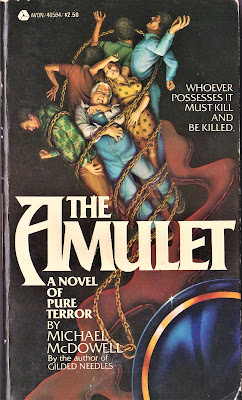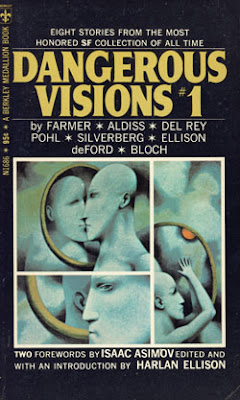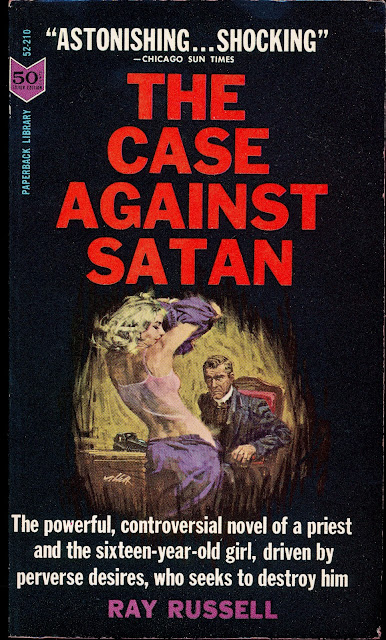The horror genre isn't generally thought of as being socially conscious, and historically was often seen as just the opposite. This has changed most notably in the last few years, but back in the Eighties and into the Nineties, horror entertainment was more a place to indulge in anti-social behaviors than in healthy ones. Famed splatterpunk duo
John Skipp and
Craig Spector, those "bad boys" of horror novelists, however, evinced an awareness of societal ills along with their penchant for depicting scenes of no-holds-barred graphic gore and violence in Eighties classicks like
The Scream (1988) and
The Light at the End (1986).
This aspect grew to the forefront by the time they published their ambitious second-to-last novel,
The Bridge (Bantam Books/October1991/cover art by
Lisa Falkenstern). This was adult, eyes-open horror, the guys were saying, writing about the here-and-now and not looking to horror for escape any longer: humans were no longer the sole items on the menu, for Earth itself (her self?) was on the chopping block. It was time to acknowledge that, ecologically, the planet was in dire straits.
Ecological horror stories were more a part of science fiction than horror (Skipp has often name-checked
The Sheep Look Up, a 1972 dystopian novel by John Brunner, which depicts a world so polluted by human endeavors it is almost uninhabitable), but
The Bridge is eco-horror in high gear.
An impassioned plea for the state of our very planet that pulls no punches, it is an apotheosis of the authors' combined talents. That is, it has most of what's good about their work and some of what's bad, but it's all delivered with an earnest intensity. Dig the back-cover copy, which gives only a hint of what's lurking inside:
The good times start when two young redneck cousins, Boonie and Drew,
working for Boonie's dad's dumping company, furtively chuck barrels of toxic
waste into a nice secluded area in the Pennsylvania
hinterlands, from the
Black Bridge, a spot in the Codorus Creek (yes, a real place!). This is the breaking point, as S&S tell us in the pretentious italics that will run rampant throughout the novel, "a sin-eater since
the Industrial Revolution, a chemical cessway" choked (illegally, of
course) with the runoff of modern convenience: now a primordial
stew giving birth to a new form of life, which S&S will dub
"Overmind." And boy are we in trouble.
What results is so awful, so mind-bendingly terrifying, so rarefied and beyond man's ken that S&S have no choice but to revert to free verse poetry to describe it:
born of poison
raised in poison
claiming poison for its own
it rose
a miracle of raw creation
hot black howl of life and
death intertwined and converted to
some third new option
2010 reprint, Leisure Books
And so on. It's "an enormous oily serpent" that "fractures physics, disembowels logic." It is made of rotting fish and broken barrels, the sludge and slurry of the creek, and it—the Overmind—wants the bodies and souls of us hapless littering mall-dwelling gas-guzzling dullards to wreak its vengeance. Host and parasite in one. Puppets of this sentient sludge. It devours and expels, creating a misshapen, oozing, zombie horde to act as avatars of our own destruction. It is the literal embodiment of the processes that created it: the greedy, insatiable eating machine. Shoveling resources in the one end, shitting poison out the other. A fat, blind, dying carcass, smothering all as it wallowed in its own excrement.
These grotesqueries on display are beyond reproach, offered up with spunky elan, gloopy and disgusting. This roiling mass of deformed life, "toxic ground zero," is eager to ingest everything it comes into contact with, to make it one with the Overmind. Reanimated bodies, human and helpless animal alike, march—or, more accurately, drive trucks filled with nuclear waste barrels—upon the unsuspecting small town of Paradise, PA: At the center of the only Hell that mattered. The Hell that mankind had created on Earth.
Our cast of characters is large, varied, as S&S dip down and then back up the social ladder. There are the aforementioned rednecks, duplicitous
businessmen, young couples in love, a pregnant woman in crisis and her
New Age friend, television reporters and crew, nuclear power plant
workers, hazmat crew members, and teenage punk rockers. S&S keep
things on the move, never lingering too long on any one narrative
thread, spiking the wobbly narrative with odes
to pain like a raggedy ratcheting metal fist, a screaming bonesaw violation
so far beyond ordinary pain it boiled down endorphins and tortured the
steam... blowtorching her mind into into crisp hyperclarity.
The Bridge is a perfect work of splatterpunk. And splatterpunk is not simply outrageous gore—it has heart, it has a
conscience, an adolescent energy; it has raw primal emotions about injustice and disparity (y'know:
punk) and
the ironic confluence of the two is what made
splatterpunk a thing. And if
The Bridge
has one thing, it's that: an emotional core of outrage, betrayal,
injustice surrounded by a spiky, unruly, deeply pissed off surface eager
to scrap, bringing mucilaginous pustular rotting amorphous tentacled
things to a gunfight.
Our old buddy
Harlan Ellison is surely one of the fathers of this righteous screed, as S&S
shift into full-throttle,
Deathbird Stories-style jeremiad mode,
a kaleidoscopic apocalypse harrowing our souls, a beast screaming at the heart of
the world. I was also reminded of the infernal parade in works like
Clive Barker's "Skins
of the Fathers" and
Stephen King's "The Mist." Timely, modern movies like
The China Syndrome,
Network, and the soul-deadening BBC-TV movie
Threads—which I first heard of when Spector mentioned it in
Silver Scream—also have deep echoes here; I'm sure that was intentional, and it was all cool with me.
this bad boy had a soundtrack
The novel has faults, though, many. I read it when it came out, and the only thing I recalled before this reread was an awkward, lopsided vibe. This vibe remained: the set-up is bold and powerful, but there's no plot, only the
one-way-ticket to oblivion, a downbound train doomed to destruction,
peopled solely with folks in service to it. Hysteria and mania are at
fever pitch; some readers may tire of the terse, melodramatic
single-sentence paragraphs, or the overly earnest emotional outbursts, the endless fucking italics, or the glib, smart-alecky, even dated approach to violence, with a phrase like "Vlad the Impaler on a Funny Car Saturday" clunking in. None of the characters is the
protagonist, per se, and none really come to life except when they're
about to die, if even then. And the less said about the garden gnome orgy (pp. 260-261), the better! (Also: do not read past Chapter 60. Two very, very short pages follow, and they are from hunger and add not a drop to what you've just read.)
What we have then is a polemic aimed at the people who dump and poison without a backward glance or a twinge of remorse, who would use our environment, our home, as a dumping ground so they can fill their pockets. This ain't rocket science; S&S aren't saying anything particularly new. But that's not the point. The point is to deliver this oft-ignored message to the masses with a white-hot flaming sword, and that sword is The Bridge. It's not fully a novel; it's "a warnin' sign on the road ahead," as Neil Young once sang. But those people at fault will never read a book like this (although I wouldn't be surprised if some were Neil Young fans), and so S&S are left to include a long appendix filled with environmental tips n' tricks and the addresses of ecological organizations. It's (still, alas) up to us, and us only.

It was a ring of thorns rising high into the viscid swirling fog... ten thousand barbed biting tendrils... taking on the appearance of armor. there were easily a hundred thousand bristling, glistening spikes pointing menacingly... pulling themselves up...
Despite those enumerated faults, I quite enjoyed my revisit to The Bridge; I was most often captivated by the book's gleeful passion, the commitment to its monstrous, unavoidable finale. And there’s no doubt eco-horror is more relevant than ever, which only added more sting to the proceedings. John Skipp and Craig Spector would only write one more novel after this, then quit for reasons I've never been able to ascertain—personal fallout? The waning of the paperback horror era? Creative differences? No matter, really. With one of the best, literally explosive, most disheartening climaxes in horror fiction of
the era, The Bridge is an apex of the "new," early Nineties horror, delivered unto you without a care in the world—except saving it.
Horror was love, in this Brave New Hell: the capacity for caring, and for sharing pain.
To find oneself both in love and in Hell was more than torture, worse than madness.
It was tantamount to sin.




















.jpg)
%20.JPG)



































